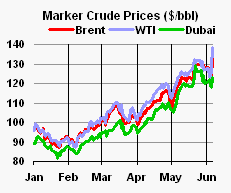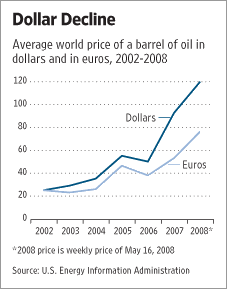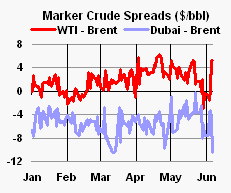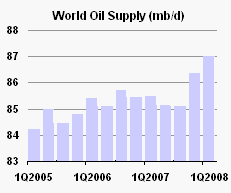With oil prices having more than doubled over the last 12 months, various reasons are being cited for the price increases.
Adhip Chaudhuri, a visiting professor of economics at Georgetown University’s campus in Doha, Qatar, explains the cause and effect of high oil prices.
Is the increase in oil prices plunging the global economy into stagflation?
The United States is, for all practical purposes, in a recession. The European Union’s growth rates are being revised downwards below 2 per cent. The shine is coming off even China, India and Korea.
The recessions and the low growth rates represent stagnation and hence connote the ‘stag’ part of “stagflation”, and high oil prices have a lot do with it.
Oil prices, together with simultaneous, huge increases in food prices, have increased worldwide inflation rates. Both China and India now have high inflation rates with China at almost 8 per cent and India at 11 per cent. The rising inflation is the “flation” part of “stagflation”.
The worse thing about stagflation is that the central banks find themselves in a dilemma. If they lowered interest rates to spur growth, they would raise inflationary expectations. On the other hand, if they fought inflation by raising interest rates, the reduction in money supply will have contractionary effects on the GDPs of their countries.
For policymakers stagflation is a “lose – lose” situation.
Is the growth in world demand for oil the main reason?

|
Demand is one part of what the money market calls “fundamentals”. The other is, of course, supply. In the opinion of the Bush administration, and the majority of the Wall Street establishment in the US, demand is the principal reason why oil prices are going up astronomically. However, this point of view does not correspond to facts.
Consider first the oft-mentioned demand from “China and India” which is frequently put forward as the principal reason why oil prices are going up.
According to official statistics published by the United States government, China consumed an additional 377,000 barrels of oil per day during 2007.
However, during the same time period Germany and Japan together decreased their consumption by 380,000, and hence, the net effect of China’s increased consumption is zero.
Even if China doubled its consumption in the first half of 2008, say to stockpile for the Olympics, the increment would be a drop in the bucket of total world consumption of 86 million barrels per day.
The same is true of India. It increased consumption by only 150,000 barrels per day during 2007, which is virtually indiscernible in the total world demand.
Notice also that the sum of additional consumption from “China and India” barely exceeds 500,000 barrels, an amount that Saudi Arabia has promised to increase production by.
Finally, the US has projected that the net increase in oil consumption during 2008 will increase by one million barrels per day, which is about 1.1 per cent. How can such a small increase in demand increase oil prices by 100 per cent between July 2007 and July 2008?
What is happening with the supply of oil?
The supply of crude oil has been remarkably stagnant over the last three years. According to official US statistics, the production of crude worldwide was 84.63 million barrels per day in 2005, and it was 84.55 million barrels per day in 2007. Thus, even small increases in demand over the last three years have put upward pressures on prices.
The near-term supply situation, according to the International Energy Agency, is not all that bad. Saudi Arabia will be adding to their capacity, deepwater Nigerian production will start in 2008, and Iraqi production will see an increase. If one added up the growth in all forms of energy, namely crude oil, natural gas, and biofuels, according to IEA there should be an increase in supply capacity of 1.5 million barrels during 2008.
Notice that amount of increase in supply is greater than the projected increase in demand for 2008 amounting to 1 million barrels per day. The supply projection for 2009 is even better. The supply capacity is expected to increase by 2.5 million barrels, which will outstrip the growth in demand comfortably.
It is the very short-term supply disruptions which seem to be more important for an increase in oil prices. Real disruptions may come from labour strikes in Venezuela, hurricanes in the Gulf of Mexico, and rebel attacks in Nigeria. Given that the demand and supply situation is so tight, even the slightest of bad news can increase the price of oil in the futures and spot markets noticeably.
Can the weak dollar be blamed for high oil prices?
Asserting that the “weak dollar” is a significant reason behind the rise in oil prices has become as ritualistic as asserting that “China and India” are the cause. And yet, the forces which determine the foreign exchange value of the dollar against the euro, the yen, or the pound are distinctively different from those that determine the price of oil.
 SOURCE: David T. King, “Oil Is Up Because the Dollar Is Down,” Wall Street Journal, 23 May 2008, p. A13 |
There is, however, one logical argument which can sometimes provide a sufficient explanation as to why a depreciating dollar and increasing oil prices are inversely related: if the dollar weakens against the euro, the ability of the oil-exporting countries to buy European goods will decline because their oil exports are denominated in dollars.
The Europeans, at the same time, will be able to pay the higher dollar prices of oil because the euro has appreciated. Clearly, to keep their purchasing power over European goods constant, the oil-exporting countries need an increase in oil price approximately equal to the depreciation of the dollar.
However, for the first six months of 2008 the dollar has depreciated against the euro by only 7.5 per cent, while oil prices have gone up by about 50 per cent.
Surely, both Americans and Europeans are paying much higher prices for oil than can be explained by a “weak dollar”.
Is speculation, then, a major factor?
The energy ministers of Saudi Arabia and Qatar asserted for the first time in public at the recent Jeddah meeting of major oil producing and consuming nations, that speculation in the oil futures markets was the most important reason why current oil prices are going up.
The United States Senate has been holding hearings in front of several committees since 2006 on the lack of regulation and oversight by the official Commodity Futures Trading Commission (CFTC) in the New York Mercantile Exchange (NYMEX) one of the two locations for oil futures.
In a recent testimony to the Senate, a hedge fund trader presented data to show that outstanding speculative positions in all commodities futures has reached $250 billion by March 2008, as compared to only $13 billion at the end of 2003.
As far as speculation specifically in oil futures is concerned, representative Bart Stupak (Democrat-Michigan), the head of the House Energy and Commerce Committee, announced recently that 71 per cent of all oil futures were owned by institutional investors.
The institutional investors, which consist of but is not confined to state pension funds and university endowments from the United States, have been pouring funds into indexed commodity funds as part of a strategy of portfolio diversification.
The traditional assets, in which they would have otherwise invested in, namely stocks and bonds, have been yielding negative returns after inflation.
These investors can buy futures contracts with only a 5 per cent margin down payment. In addition the regulatory environment is very slack, filled with loopholes which bypass whatever few regulations that are on the books.
While there are dollar limits to positions that the institutional investors might take in the NYMEX, they are allowed to conduct “swaps” with the investment banks like Goldman Sachs and Morgan Stanley, and thereby manage to roll over their “buy” positions. This way they never have to take physical possession of the oil that they put in “buy” orders for.
If speculation is what is driving oil prices up, then it stands to reason that such high prices should lead to an excess supply of crude in the world. There are signs that such an excess supply is indeed building up, albeit slowly, much like the way the excess supply of housing emerged in the United States.
Fuel consumption has declined in the US sharply. We have already noted that oil consumption in Japan and Germany are actually decreasing.
Consumers in China and India have been insulated from the high world prices of oil until very recently with domestic subsidies. However, China has raised the prices of various petroleum products amounting to an average increase of 18 per cent, and so has India, by 13 per cent. The decrease in the demand for oil will start strengthening soon.
The biggest argument for speculation to be the single-most important cause for oil price increases in 2008 is: What else could have doubled the price of oil in one year?
This interview was first published in the Web site of Al Jazeera on 12 July 2008, and it is reproduced here for educational purposes.
|
| Print




